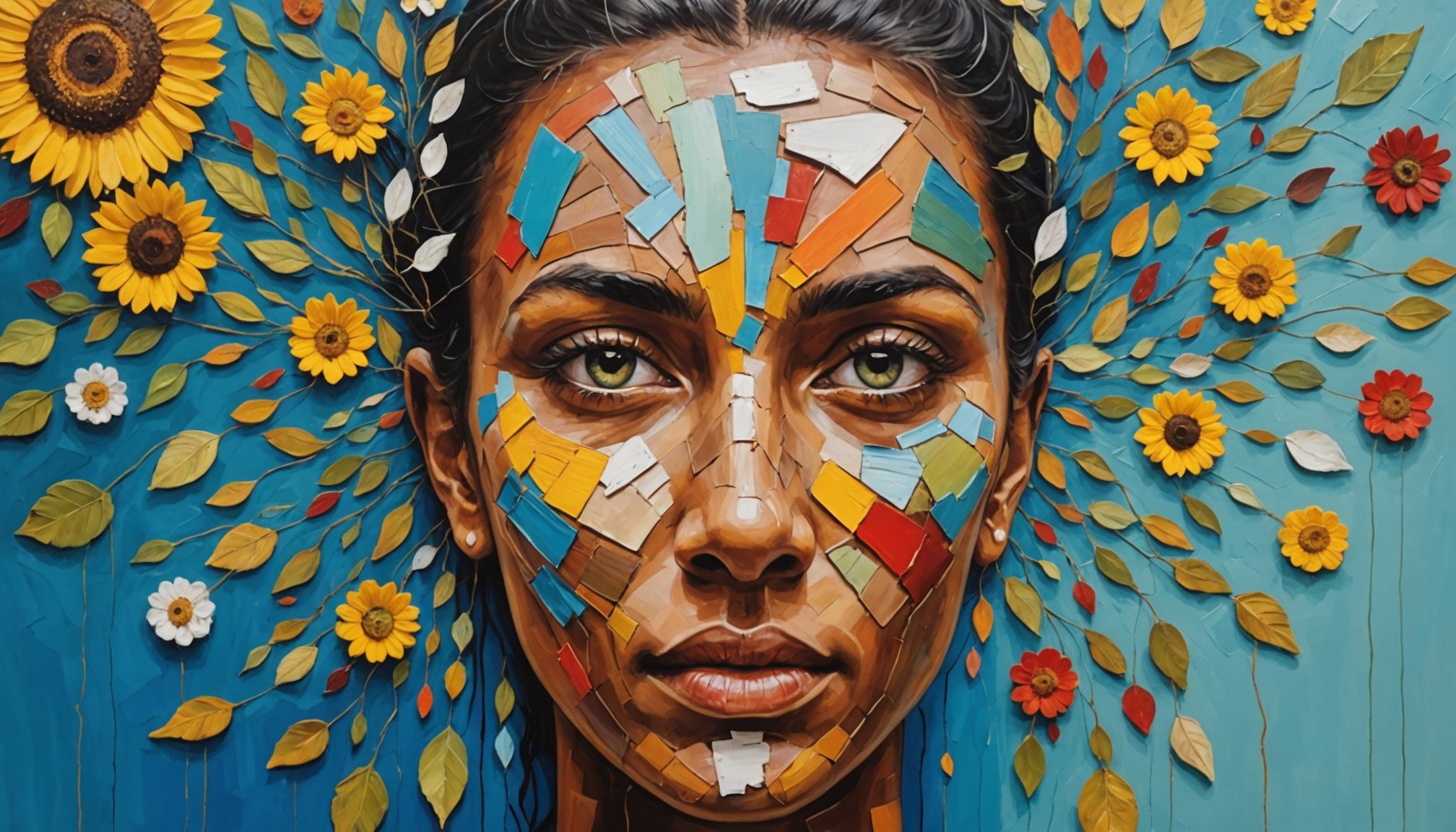Unlocking Healing: The Transformative Power of Art for Those with Post-Traumatic Stress Disorder
Understanding PTSD and the Need for Alternative Therapies
Post-Traumatic Stress Disorder (PTSD) is a complex and debilitating condition that arises after an individual experiences a traumatic event. It can manifest through a variety of symptoms, including flashbacks, nightmares, severe anxiety, and uncontrollable thoughts about the event. Traditional therapies, such as cognitive-behavioral therapy (CBT) and medication, are often used to treat PTSD, but they may not be sufficient or suitable for everyone.
This is where art therapy steps in, offering a unique and powerful approach to healing. Art therapy is a form of psychotherapy that uses the creative process of making art to improve an individual’s physical, mental, and emotional well-being. Here, we will delve into the transformative power of art therapy for individuals with PTSD.
In the same genre : Transforming Spinal Cord Injury Recovery: The Potential Benefits of Aquatic Therapy
The Role of Art in Healing Trauma
Art therapy provides a safe and expressive outlet for individuals to process their traumatic experiences. Unlike traditional talk therapies, art therapy does not require the individual to verbalize their trauma, which can be particularly beneficial for those who struggle with verbal expression or find it too painful to discuss their experiences.
How Art Therapy Works
- Creative Expression: Art therapy allows individuals to express their emotions and experiences through various forms of art, such as painting, drawing, sculpture, or even writing. This creative process helps in externalizing the internal turmoil, making it easier to manage and understand[5].
- Self Discovery: Through the act of creating art, individuals can gain insights into their thoughts, feelings, and behaviors. This self-discovery is crucial for personal growth and healing[1].
- Emotional Release: The process of creating art can be therapeutic, allowing individuals to release pent-up emotions in a healthy and constructive manner. For example, a person might create a piece of art that represents their anxiety or fear, thereby acknowledging and dealing with these emotions[4].
Benefits of Art Therapy for Individuals with PTSD
Art therapy offers a multitude of benefits for individuals with PTSD, making it an invaluable addition to their treatment plan.
Also to read : Exploring the Impact of Daily Curcumin Intake on Inflammatory Markers in Rheumatoid Arthritis Management”
Reducing Anxiety and Stress
Art therapy has been shown to reduce anxiety and stress levels in individuals with PTSD. The calming and meditative nature of the creative process can help in managing symptoms such as hyperarousal and hypervigilance.
Improving Mental Health
- Self Esteem: Creating art can enhance self-esteem and confidence. When individuals see their creations, they often feel a sense of accomplishment and pride, which can be particularly empowering for those struggling with PTSD[5].
- Self Awareness: Art therapy helps individuals develop a better understanding of themselves, including their strengths, weaknesses, and emotional triggers. This increased self-awareness is crucial for managing PTSD symptoms[1].
Facilitating Emotional Expression
- Non-Verbal Communication: Art therapy provides a non-verbal means of communication, which is especially helpful for individuals who find it difficult to express their feelings through words. This can include those who have experienced trauma that has left them speechless or emotionally numb[3].
- Processing Traumatic Experiences: Through art, individuals can process and integrate their traumatic experiences in a way that feels safe and manageable. For instance, creating a timeline of their life events, including the traumatic experience, can help in contextualizing and making sense of their past[1].
Types of Art Therapy for PTSD
There are several types of art therapy that can be particularly beneficial for individuals with PTSD.
Visual Art Therapy
- Painting and Drawing: These mediums allow individuals to express their emotions and experiences through color, shape, and form. For example, a person might paint a scene that represents their traumatic event, using colors and textures to convey the emotions associated with it.
- Sculpture: Creating three-dimensional art can be a powerful way to express complex emotions and experiences. It allows individuals to work with different materials and textures, which can be very therapeutic.
Expressive Writing and Poetry
- Journaling: Writing down thoughts, feelings, and experiences can be a therapeutic way to process trauma. This can include writing poetry or short stories that reflect the individual’s emotional state.
- Narrative Therapy: This involves creating a narrative or story about the traumatic experience. This can help in making sense of the event and integrating it into the individual’s life story[1].
A Comparative Look at Art Therapy and Other Therapies
Here is a comparative table highlighting the key differences and similarities between art therapy and other commonly used therapies for PTSD:
| Therapy Type | Description | Benefits | Limitations |
|---|---|---|---|
| Art Therapy | Uses creative expression to process emotions and experiences. | Non-verbal, promotes self-awareness, reduces anxiety. | May not be suitable for everyone, requires a trained art therapist. |
| Cognitive-Behavioral Therapy (CBT) | Focuses on changing negative thought patterns and behaviors. | Structured, evidence-based, effective for many. | Can be intense, requires verbal communication. |
| Eye Movement Desensitization and Reprocessing (EMDR) | Uses eye movements to reprocess traumatic memories. | Effective for reducing PTSD symptoms, relatively quick. | Can be distressing, requires a trained therapist[2]. |
| Medication | Uses drugs to manage symptoms such as anxiety and depression. | Quick relief from symptoms, widely available. | Can have side effects, does not address underlying issues. |
Practical Insights and Actionable Advice
For those considering art therapy as part of their treatment plan, here are some practical insights and actionable advice:
Finding an Art Therapist
- Qualifications: Ensure the therapist is trained and certified in art therapy. Look for credentials such as ATR (Art Therapist Registered) or ATR-BC (Art Therapist Registered-Board Certified)[5].
- Comfort Level: It is crucial to find a therapist with whom you feel comfortable. This can involve an initial consultation to discuss your needs and expectations.
Starting Your Art Therapy Journey
- Begin Small: Start with simple art activities such as drawing or coloring. This can help you get comfortable with the process and build your confidence.
- Experiment with Different Mediums: Try various forms of art to see what works best for you. This could include painting, sculpture, writing, or even music.
- Be Patient: Healing is a process that takes time. Be patient with yourself and allow the art therapy to unfold naturally.
Real-Life Examples and Anecdotes
To illustrate the effectiveness of art therapy, let’s look at a real-life example:
Sarah’s Story
Sarah, a veteran, had been struggling with PTSD after serving in a combat zone. She found it difficult to express her feelings through words and often felt overwhelmed by her emotions. Her therapist suggested art therapy, and initially, Sarah was skeptical. However, after her first session, where she painted a scene representing her time in combat, she felt a sense of relief she had not experienced in years.
Over the next few months, Sarah continued with art therapy, creating pieces that reflected her journey towards healing. She found that the process of creating art helped her manage her anxiety and allowed her to process her traumatic experiences in a safe and constructive way.
Art therapy is a powerful tool in the healing journey of individuals with PTSD. It offers a unique and expressive outlet for processing traumatic experiences, reducing anxiety, and promoting personal growth. By understanding the benefits and types of art therapy, individuals can make informed decisions about incorporating this therapeutic approach into their treatment plan.
As Evelyne Josse, a therapist specializing in trauma, notes, “Art therapy provides a safe space for individuals to express and process their emotions in a way that feels natural and comfortable. It is a journey of self-discovery and healing that can be incredibly transformative.”
In conclusion, the transformative power of art for those with PTSD is undeniable. Whether through visual art, expressive writing, or other creative mediums, art therapy offers a holistic approach to healing that can complement traditional therapies and provide a path towards a more balanced and fulfilling life.











